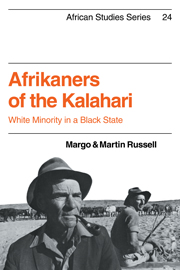Book contents
- Frontmatter
- Contents
- List of illustrations
- Acknowledgements
- A note on terminology
- 1 Southern Africa
- 1 The mundane Kalahari: an introduction
- 2 Boers, trekboers and bywoners: 1898–1930
- 3 Into the cash economy: 1930–72
- 4 Ghanzi Afrikaners 1973: a domestic description
- 5 Preserving boundaries: similarities, ambiguities and avoidances
- 6 Boers and Bushmen: dependence, interdependence and Independence
- 7 Sharing religion: attitudes to the conversion of the Bushmen to Christianity
- 8 Boers, bureaucrats and blacks
- 9 Prospect: whites in a black state
- Notes
- Bibliography
- Index
4 - Ghanzi Afrikaners 1973: a domestic description
Published online by Cambridge University Press: 04 August 2010
- Frontmatter
- Contents
- List of illustrations
- Acknowledgements
- A note on terminology
- 1 Southern Africa
- 1 The mundane Kalahari: an introduction
- 2 Boers, trekboers and bywoners: 1898–1930
- 3 Into the cash economy: 1930–72
- 4 Ghanzi Afrikaners 1973: a domestic description
- 5 Preserving boundaries: similarities, ambiguities and avoidances
- 6 Boers and Bushmen: dependence, interdependence and Independence
- 7 Sharing religion: attitudes to the conversion of the Bushmen to Christianity
- 8 Boers, bureaucrats and blacks
- 9 Prospect: whites in a black state
- Notes
- Bibliography
- Index
Summary
In 1973 a third of the farms on the Ghanzi ridge were owned by absentee landlords. Some of these were South African entrepreneurs, operating individually or as companies, who had bought up land in 1964 when the price was dropped 25 per cent in an attempt to find buyers. Some were ‘leading African producers’, settled in accordance with government policy to dissolve the racially segregated pattern of freehold land ownership inherited from the colonial period, who had land rights elsewhere and were using the land at Ghanzi as cattleposts (Botswana Daily News, 9 February 1967). A few were Afrikaners who had inherited land and were holding on to it despite settlement elsewhere, perhaps intending to return when they had amassed sufficient cattle or capital to farm. The resident farmers were predominantly Afrikaners (thirty-six out of sixty-five households) but also Coloureds (fifteen), blacks (two) and English-speaking whites (twelve). The Coloureds tended to be concentrated to the west of the Ghanzi block, in Xanagas, an adjacent farming area.
The contemporary life style of the resident Afrikaners is the central focus of this chapter. Although most resident farmers are Afrikaans, Afrikaners are very much an overall minority, being less than a tenth of the 1971 farming block population of 4921, the majority of whom are Bushmen.
Because the farms are large, the farmhouses are usually several kilometres apart, though two or three may cluster strategically about a pan which their boundaries intersect.
- Type
- Chapter
- Information
- Afrikaners of the KalahariWhite Minority in a Black State, pp. 40 - 57Publisher: Cambridge University PressPrint publication year: 1979



